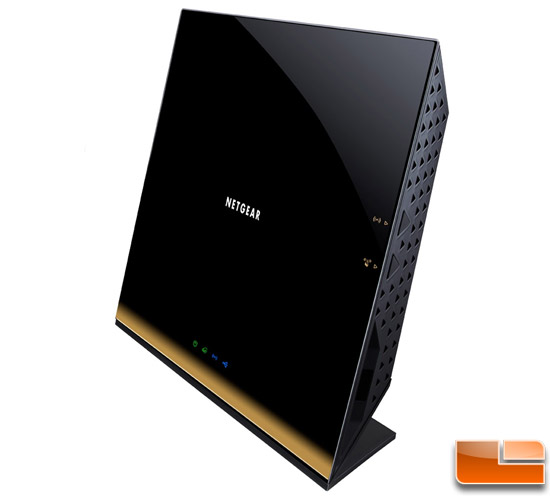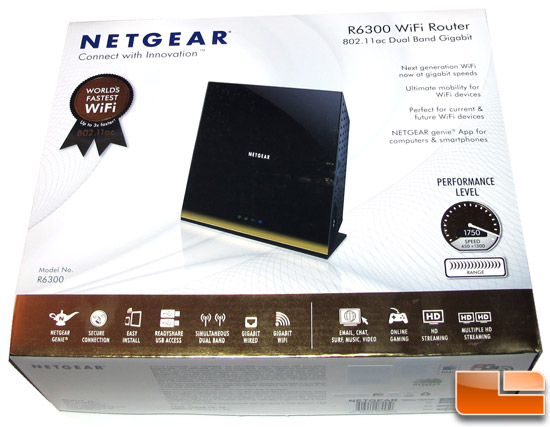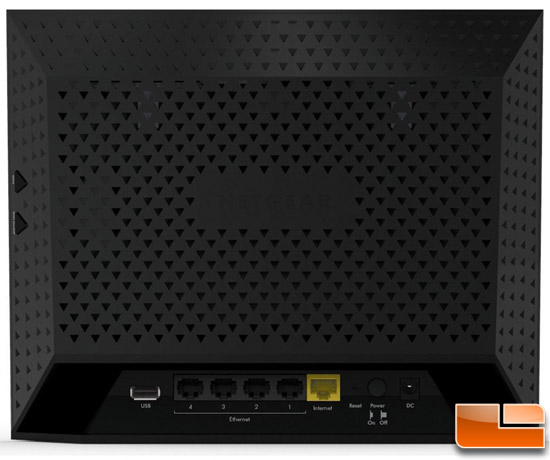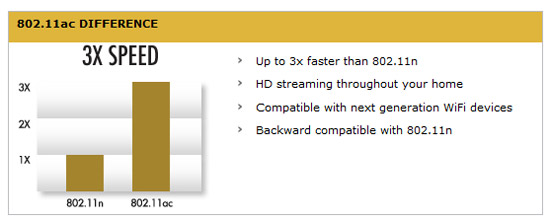Netgear R6300 802.11ac Wireless Router Review
Netgear R6300 – Netgear’s Newest Flagship Router

Netgear seems to have solved that problem by introducing their newest flagship router, the Netgear R6300 WiFi Router. Besides the sleek physical features, this Netgear features the next-generation Wi-Fi standard also known as 802.11ac which as we have seen is a monster step beyond anything that you could hope to get under the older, legacy standard, 802.11n. When it comes to pricing the Netgear R6300 really isn’t that bad, coming in at $189.99 shipped. If you wanted the Netgear WNDR4500 N900 router you are looking at $149.99 shipped. So, at the end of the day you would need to pay an extra 26% or $40 to get the flagship 802.11ac router over the flagship 802.11n wireless router.

Netgears R6300 is their first 802.11ac router designed to deliver next generation Wi-Fi Gigabit speeds. Yes, you read the correctly, Gigabit speeds over wireless! The theoretical top speed of the Netgear R6300 is 1.3Gbps and is capable of packing three times more data into each spatial stream. The R6300 is a dual band router, so if you change the settings you can put slower devices on the 2.4GHz band and place faster devices on the 5GHz band. This router has DLNA support which will allow you to securely stream media across multiple devices.
After reviewing and loving Netgears N900 router, the WNDR4500, we have high expectations for the performance of this router. Not only does Netgear come to the table with advanced hardware designs, but their Netgear Genie has been some of the easiest GUIs we have seen for a network device. In their N900, the GUI layout is very easy to understand and quite capable.

Netgear R6300 Product Features:
- 802.11ac provides gigabit WiFi with speeds up to 1.3 gigabits/sec.
- HD streaming throughout your home
- Compatible with next generation WiFi devices
- Backward compatible with 802.11n
- Dimensions: 205 x 255 x 77 mm (8.07 x 10.04 x 3.03 in)
- Weight: 654g (1.44 lb)
- Two (2) USB 2.0 ports
- IEEE 802.11 b/g/n 2.4 GHz
- IEEE 802.11 a/n/ac 5.0 GHz
- Five (5) 10/100/1000 (1 WAN and 4 LAN) Gigabit Ethernet ports with auto-sensing technology
- WiFi Boost with high-powered radio amplifiers
- Memory: 128 MB flash and 128 MB RAM
- Advanced Quality of Service (QoS)
- IPv6 Support (Internet Protocol Version 6)
- NETGEAR Genie AppPersonal dashboard to monitor, control & repair your home network
- Push N Connect using Wi-Fi Protected Setup (WPS)
- WiFi Protected Access (WPA/WPA2PSK)
- Double firewall protection (SPI and NAT firewall)
- Denial-of-service (DoS) attack prevention
- Limited 1-year warranty minimum or longer if provided by law. Plus 90-day basic customer support.

(Click for larger image)
Netgear utilizes the new 802.11ac wireless standard designed to provide Gigabit speeds, better range, more spatial streams, and is backward compatible. The gigabit speeds are created by utilizing the 5GHz band which gives routers 3 times the speed of the 802.11n. With the frequency range being at 5GHZ instead of 2.4GHz, most household devices should not degrade the wireless signals. The 802.11ac standard is backward compatible with 802.11a/b/g and n devices so if you have these devices in your home office already, the upgrade to AC will be transparent. Of course both the client and the router need to support 5G Wi-Fi in order for your devices to work at 5G Wi-Fi speeds.

You can read more on the newest Wi-Fi AC standard in our Buffalo Air Station AC1300 review, but the most important thing to note is that for you to achieve the maximum speeds of these new routers, you client must support the 802.11ac standard. Because there arent really that many choices in AC out there as of this writing, it is vitally important that the new routers support both the new (802.11ac) and older (802.11a/b/g/n) standards. In our review of Netgears R6300, we will look to see how the router does with not only an AC environment, but in a legacy environment and a mixed environment of AC and Non-AC devices.
On the next page, we will take a look at whats underneath the hood of the R6300.

Comments are closed.